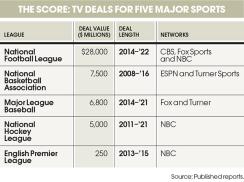To a large extent, as the Walt Disney Co. goes, so goes the sports industry. Earnings at the entertainment giant’s Media Networks division dropped 7 percent in the latest quarter, largely on the back of its ESPN cable network having to fork out more in broadcast rights fees for Major League Baseball and the 2014 FIFA World Cup.
Individual teams have recently signed television rights deals at two to three times previous levels. In 2012, when Major League Baseball became the most recent of the three major sports leagues to sign a new contract for television rights, it doubled the amount of money it reaps from Fox Sports and Time Warner’s Turner Sports. The deals, which total $6.8 billion, cover a seven-year period, from 2014 to 2021. In January the Philadelphia Phillies and Comcast SportsNet reportedly agreed to a deal worth $100 million annually over the next quarter century. That compares with $35 million a year for the previous agreement.
Do skyrocketing television rights fees for sports teams mean that they are near a peak? And given that these fees make up an important part of teams’ revenue — more than 50 percent for some National Football League teams — does this mean that prices to buy teams, which also have soared in recent years, are cresting?
Most sports industry participants say no. But according to sports economist Andrew Zimbalist at Smith College in Northampton, Massachusetts, “we are in a sports media bubble.” He maintains that rights fees will eventually stop rising and then perhaps fall, though it’s difficult to predict when. “That will have a parallel impact on franchise values,” Zimbalist says.
Sports teams and leagues are able to command such large sums because sports represents one of the few sectors of programming that television viewers will still watch live rather than view later with a digital video recorder. So these viewers are more likely to actually watch the commercials instead of fast-forwarding through them. Zimbalist points out, however, that sports viewers are changing how they watch games, with many tuning in on computers, tablets and smartphones — thus avoiding television advertising completely.

“As the different media proliferate, the value of each medium should go down,” he says. “So far, that hasn’t happened. But I think it has to. There has been a supersaturation of sports events. The supply of live sports programming has expanded so rapidly that I don’t think it can sustain price levels.”
Some problems already have arisen for broadcasters on this front. Comcast SportsNet Houston, home to the Astros and the Rockets, declared bankruptcy in 2013 after proving unable to complete carriage deals with several cable and satellite service providers. On the West Coast, Time Warner Cable SportsNet LA, the Los Angeles Dodgers network, is available to only 30 percent of the local audience, as cable and satellite service providers have balked at the network’s high prices. Sports channels are hiking their rates just as budget-tightening U.S. households are cutting the cable cord in favor of Web-based programming services. “[Networks] won’t be able to sustain the marketplace,” Zimbalist says. “This will end the boom.”
Others aren’t so sure. “This question [of whether there’s a sports media rights bubble] has been asked for at least 20 to 25 years,” says Robert Caporale, founder and chair of Game Plan, a sports and entertainment advisory firm in Miami Beach, Florida. “So far, it hasn’t happened, and there doesn’t seem to be anything on the near horizon to indicate it will happen.”
Experts say broadcasters’ demand for sports content is growing. For example, Fox and NBC are trying to position themselves as competitors to ESPN. “There are so many companies that want to be able to advertise on that kind of programming,” says Caporale. “The fact that rights fees are increasing is evidence of the scarcity and appeal [of sports programming] to media companies and sponsors,” agrees Phil de Picciotto, founder and president of Norwalk, Connecticut–based sports management company Octagon.
A possible sign that the peak hasn’t yet been reached for sports rights fees is the television deal signed by Major League Soccer in May, says Steve Gans, who advises soccer team executives as a principal at Professional Soccer Advisors in Newton, Massachusetts. The deal will bring MLS an average of $90 million annually for the next eight years, compared with $18 million a year at present. “We’re even seeing leagues without a history of high television ratings receiving record contracts because the networks are very desirous of the product,” Gans says, referring to the MLS deal.
The problems encountered by the networks in Houston and Los Angeles show how distribution agreements can be a blip for television rights. For example, the now highly successful Yankees Entertainment & Sports (YES) Network initially wasn’t available to many viewers in its New York City tri-state television market.
The only major U.S. professional sports league whose television deals are set to expire before the end of this decade is the National Basketball Association, whose broadcast contract ends in 2016. Analysts expect the NBA to command a major increase — getting as much as double its present $930 million a year in TV revenue.
See also our piece on how investors can incorporate sports analytics technology, “Hedge Fund Moneyball: Big Data, Sports and Finance.”






